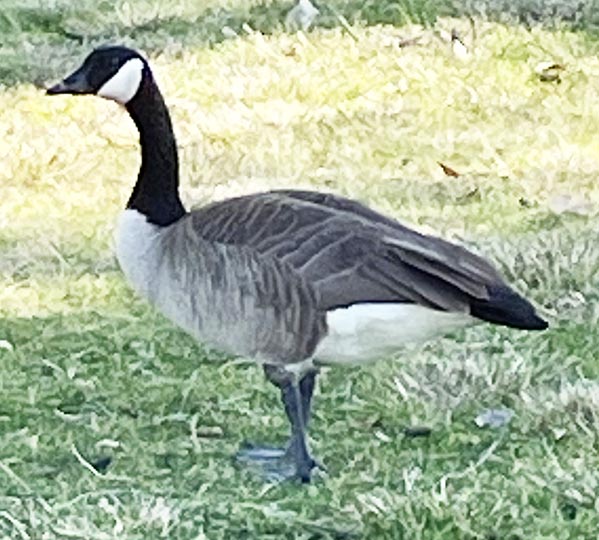In late 2025 and early 2026 (i.e. the fall and early winter seasons), I and my oldest daughter, observed the following southward-migratory freshwater birds in two bodies located in northern Los Angeles County, southern California. One of these areas is in a community called Bridgeport (elevation 1165 feet) in, a master-planned community, with water canals next to homesites. The other area is the southern-tip of Castaic Lake (elevation 1151 feet), a large reservoir. Bridgeport is 6 miles (via straight line-bird flight) due southeast of Castaic Lake.
Note: This was our first bird-watching experience. Who knew how interesting birds can be.
IMAGES OF OBSERVED BIRDS AND COMMENTS
Canada Goose
Branta canadensis
white area on cheek; dark neck, back, and tail; white belly, body
length 22-40 inches; weighs up to 18 pounds
----------
Snow Goose
Chen caerulescens
white body, black wing tips (white phase); dark body, white head and neck (blue phase)
body length 24-30 inches
----------
Mallard Duck
Anas platyrhynchos
male: head and neck glossy green, with white rim
female: brown overall, webbed feet
commonest duck in the world (America, Europe, & Asia)
body length 16-24 inches
----------
American Coot (the birds, not “old paleontologists”)
Fulica americana [“fulica” is the Latin word for coot]
dark, ducklike
white bill and white-frontal shield, reddish eyes
grayish-white toes (lobed rather than webbed), green legs
body length 13 to 15 inches
As a coot swims, it typically “bods” it head. These birds often do short dives after they make a little jump first. The feet of coots are green and not webbed; instead, they have “flaps”/”lobes” on their long and stout toes. These unusual shaped feet aid in their excellent swimming and diving abilities. Coots cannot fly as well as a duck does, but, never-the-less, coots do a good job of flying taking a relatively long start (i.e., runway flapping).
The fossil record of coots is sparse: from mid-Pleistocene to present day (Olson, 1974).
----------
Western Grebe
Aechmophorus occidentalis
Black cap, gray-black wings, white body
Body length 22 to 30 inches
Good divers
Body length 22 to 30 inches
(closely resembles the double-crested cormorant, see below)
----------
Double-Crested Cormorant
Phalacrorax auritus
Large, dark bird with orange on throat
They eat fish by diving (for relatively long times) for them
Flocks can be mistaken for Canada Geese
Length 2.5 to 3 feet
Good fliers, silent without any “honking”
----------Great Egret
Casmerodius albus
White bird, neck long and thin (elegant birds)
Bill orange or yellow
Legs and feet black
These birds nest in trees.
Body length 36-42 inches
----------
Green Heron
Butorides striatus
Small size, brownish, red-brown neck, orange legs
Very sharp-pointed orange bill, orange legs
Body length 12-22 inches
This bird can stand motionless overlooking water and can dive.
----------
Birds seen at Bridgeport
based on several trips
Abundant sightings
American Coots
Mallard Ducks
Canadian Geese
Fairly Common sightings
Egrets (white, tall)
Uncommon sightings
Double-Crested Cormorants
Very rare sightings:
Western Grebe
Green Heron
Birds seen at Southern End of Castaic Lake (Reservoir)
based on a single visit
Abundant sightings
Canadian Geese
Uncommon sighting
Western Grebe
ADDITIONAL COMMENTS
In the last 25 years or so, the classification of birds, like all living organisms, has undergone significant revisions based on DNA studies, as well as via the re-evaluation of time-honored, physical and behavioral features. In this present blog post, I have incorporated the latest classification information available to me.
All birds are classified as Kingdom Animalia, Phylum Chordata, and Class Aves, and numerous orders, families, genera, and species. Currently, there are 23 recognized orders and 9,700 species of birds (Wikipedia, 2005).
Using the online source: worldbirdnames.org, I tried my best to classify, using modern thinking, the freshwater birds (fowl) observed during the field work for this blog post:
TAXONOMIC GROUPS OF THE OBSERVED BIRDS (ALL OF WHICH ARE ILLUSTRATED ABOVE):
PALEOGNATHAE
---Gallonaseres
Anseriformes (includes many water fowl)
Canadian goose
Snow goose
Mallard duck
---Neoaves
Gruiformes
American Coot
Podicipediformes
Western Grebe
Suliformes
Double-Crested Cormorant
Pelecaniformes
Green Heron
Snowy Heron (Great Heron)
Credit:
A friend of my oldest daughter was very helpful in identifying some of the above-mentioned birds.
References Cited:
North American Wildlife. 1982. Reader's Digest. Pleastantville, New York. 559 pp.
Olson, S.L. 1974. The Pleistocene rails of North America. Museum of Natural History.
Reid, G. K. and three others. 1967. Pond life. Golden Press, New York, 160 pp.
Sprunt, A. and H. S. Zim. A guide to North American species and their habits. A Golden Nature Guide, Golden Press, New York. 160 pp.
Wikipedia, 2025.
worldbirdnames.org








No comments:
Post a Comment